The new 2.7L turbocharged 4-cylinder engine (RPO L3B) available on 2019-2020 Silverado 1500 (LT and RST models) and Sierra 1500 (SLE and Elevation models) offers capability and efficiency in a lightweight package.
The 2.7L turbo engine (Fig. 1) is built off of the new cylinder set strategy (CSS) architecture and features Active Fuel Management (AFM), Spark Ignited Direct Injection (SIDI), Dual Overhead Camshafts (DOHC), and Variable Valve Timing (VVT). It generates 310 horsepower and 348 lb.-ft. of torque, taking only 1.93 seconds to reach 90% of peak torque at 1,500 RPM.
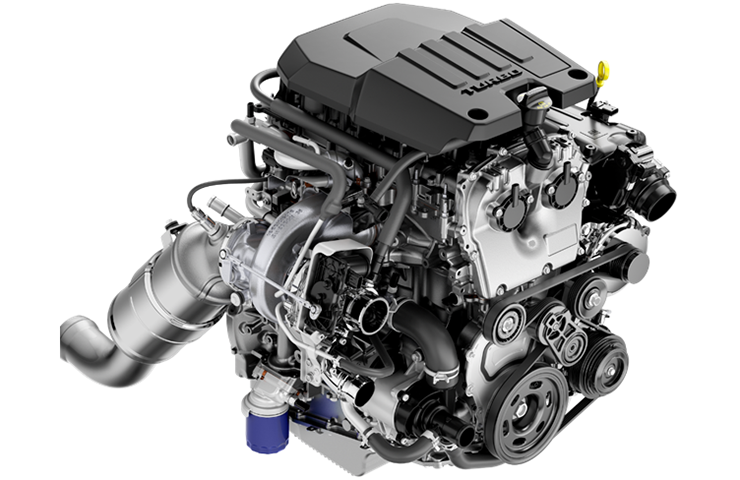 Fig. 1
Fig. 1
Compared with the 4.3L V6 engine available on Silverado and Sierra models, the 2.7L turbo engine delivers better performance in a lighter package. It weighs 80 lbs. (36 kg) less and provides 13% better fuel economy. The engine produces 9% more horsepower and 14% more torque than the 4.3L V6, providing power for a one second faster run from 0–60 MPH (6.8 seconds).
The light weight of the 2.7L engine was accomplished by using an aluminum high pressure die cast block, lower crankcase extension, and a composite intake air fuel module and oil pan.
Turbocharged Performance
The new turbocharged engine was designed to deliver performance along with fuel efficiency. It has a dual volute turbocharger (Fig. 2) that optimizes exhaust pulses energy to reduce turbo lag and increases the low-speed torque required in a truck application.
The dual volute turbocharger uses an electrically-actuated wastegate for a fast boost response and improved engine efficiency. The wastegate valve opens and closes a passage beside the turbine wheel within the turbocharger housing, which allows excess exhaust pressure to bypass the turbine into the downstream exhaust.
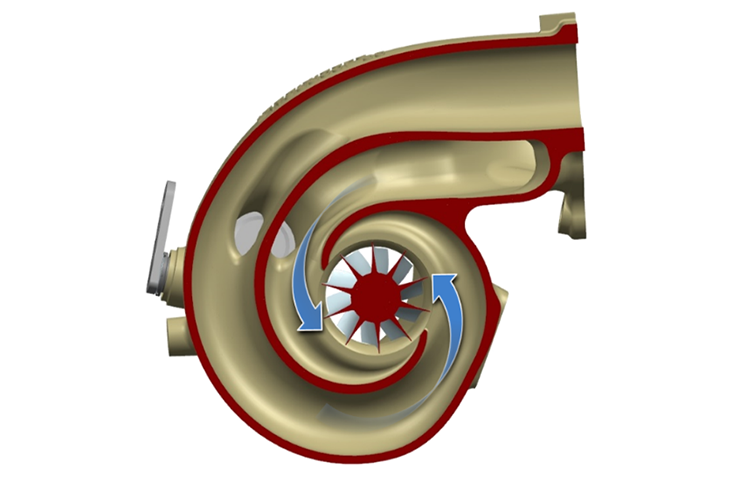 Fig. 2
Fig. 2
The electronic wastegate actuator addresses the disadvantages inherent with a pressure/vacuum-actuated system. The electric actuator operates the wastegate much faster than the pneumatically actuated system, allowing for more precise control of the wastegate in all operating conditions since valve positioning isn’t inhibited by the weight of the actuator spring and transient pressures within the system.
Each engine cycle the Engine Control Module (ECM) learns the position of the wastegate valve. Learn or reset procedures are required whenever the turbocharger, wastegate actuator, related component or sensor is replaced or serviced, including:
- Turbocharger or actuator replacement – turbocharger wastegate learn
- Turbocharger, actuator replacement, related sensor, or intake air duct – intake system learned values reset
SCS Valvetrain
To better balance power output with fuel economy, the engine also has an innovative Sliding Cam Valve Lift System (SCS) that modifies camshaft timing under changing engine demand. (Fig. 3)
The Sliding Cam Valve Lift System (SCS) has three distinct operating modes. The SCS system enables the ECM to change the camshaft lift profile of the intake and exhaust camshafts while the engine is running. The SCS has four intake camshaft profile actuators and two exhaust camshaft profile actuators that vary the camshaft lift profile sleeve position axially on the camshaft in response to commands from the ECM.
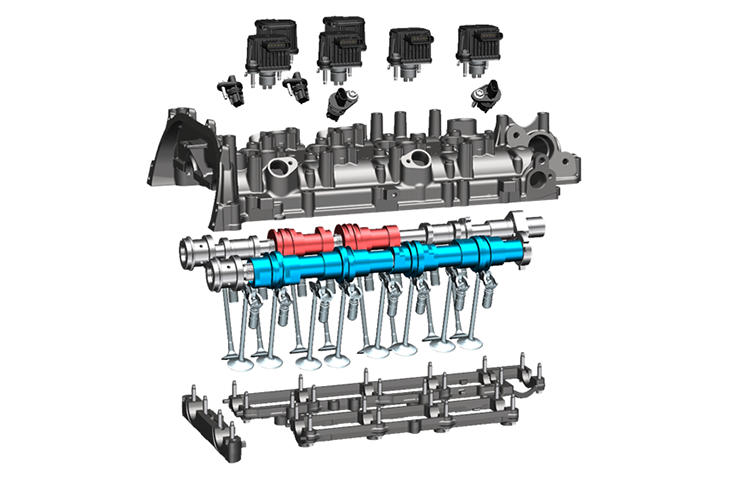 Fig. 3
Fig. 3
Each camshaft has two profile sleeves with different height cam lobes and a detent ball and spring under each sleeve that helps hold the profile sleeve into position. The SCS profile actuator solenoids push out an actuator guide pin into the shifting groove machined into the camshaft lift profile sleeve. (Fig. 4, A) When the guide pin engages the sleeve, it causes it to shift axially on the camshaft, causing the unique-sized cam lobes to be placed over the intake and exhaust valves and modify valve lift and duration.
The SCS system has three unique-sized cam lobes on each camshaft profile slider.
Power Profile: High Lift — Full capacity, conventional lift and duration. In this profile, all four cylinders are active and all valves open to their maximum lift for when the full capability of the engine is needed. (Fig. 4, B)
Economizer Profile: Low Lift — Reduced capacity (3 mm lift) changes the duration of the valve opening and closes the valve early. In this profile, all four cylinders are still active, but all intake valves open to a lower lift height to help save fuel under medium load conditions, such as highway driving. (Fig. 4, C)
Ultimate Fuel Economy Profile: AFM — Cylinder deactivation, used for increased fuel economy in light load conditions, such as highway cruising. In Active Fuel Management (AFM) mode, cylinders 2 and 3 are deactivated. (Fig. 4, D)
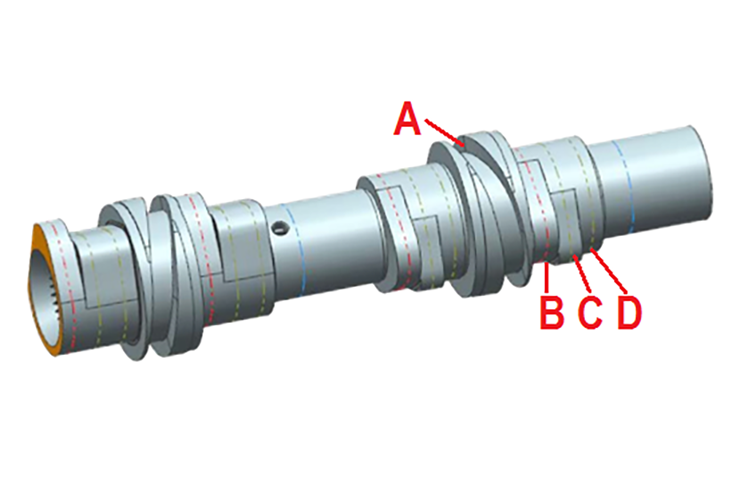 Fig. 4
Fig. 4
Active Thermal Management
A new active thermal management cooling system on the engine is used to control the coolant temperature, sending heat where it is needed to reduce friction and to heat the passenger compartment while also cooling the engine and transmission. As a result, cold start friction is reduced while combustion efficiency and exhaust cooling is enhanced during warm engine operation.
Coolant flow is supplied through the entire active thermal management system by an electric water pump mounted to the bottom left side of the engine. (Fig. 5) The ECM controls the water pump over the Local Interconnect Network (LIN).
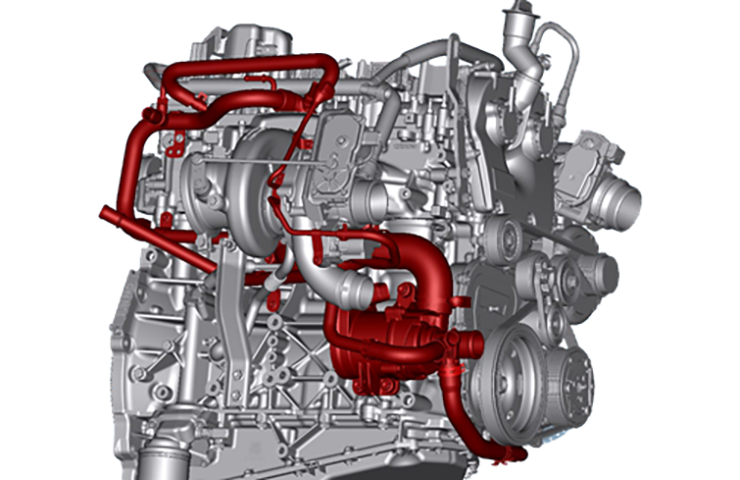 Fig. 5
Fig. 5
The main rotary valve and the block rotary valve are combined into one unit called the coolant control valve. (Fig. 6) The main rotary valve distributes coolant to the transmission and engine oil heat exchangers as well as the radiator and cabin heat exchangers. The block rotary valve provides coolant flow for engine block temperature control as well as cabin heating during warm-up.
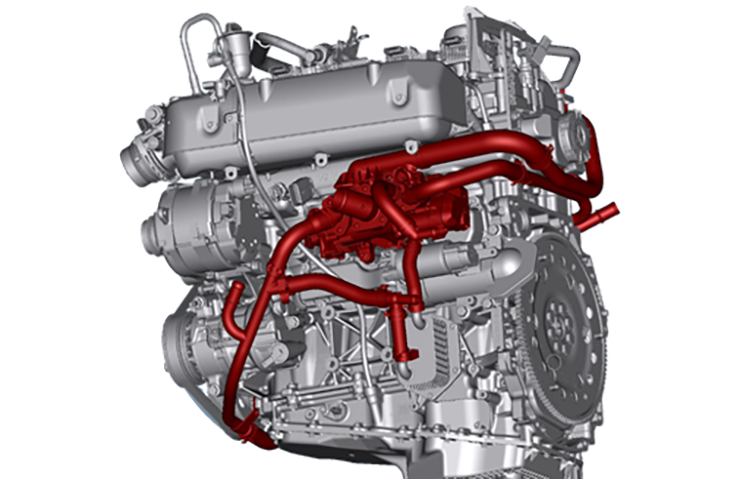 Fig. 6
Fig. 6
Designed for Durability
The 2.7L turbo engine was designed and validated specifically for the Silverado and Sierra full-size trucks.
Components designed for long-lasting durability include:
- Pistons with iron ring carriers and fully machined crowns
- Forged steel crankshaft with hardened journals
- Tri-metal bearings
- Hardened billet steel camshaft lobe packs
- High-wear resistance 8 mm roller timing drive chain
- Electric water pump that provides after-run for shut-down cooling
Throughout development, the new engine accumulated an equivalent of over one million miles of over-the-road validation testing in order to meet the durability standards of the legendary small block engine.
– Thanks to Kevin Luchansky and Jeff Kropp



















I just had and issue with the actuator bolt spins with the actuator. I didn’t realized one of the bolt tread stripped (EN-52461 Camshaft Torque Reaction Tool bolt ). How can I properly install the timing chain with new actuators?
It may be that the tool is not securely installed.
having trouble removing the camshaft actuator bolts. keeps walking the actuators off the cams, looks light it bending the tool holding the chain and actuator in place.